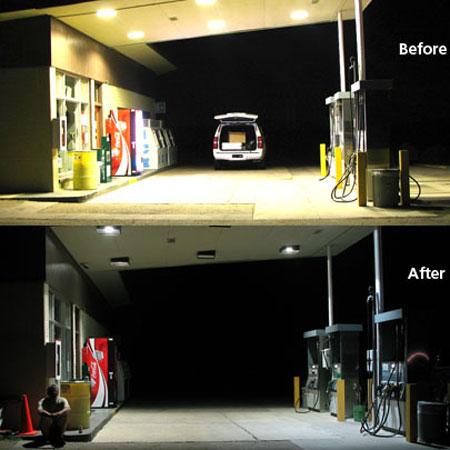NPS areas are becoming increasingly valuable as places where we can enjoy the night sky with minimal light pollution from civilization, and protecting the "dark" can also save money. A project in Big Bend National Park demonstrates what can be done, and shows what all of us can do, wherever we live.
Big Bend has recently completed the first phase of a grant-funded partnership project called “Best Lighting Practices” to improve exterior lighting throughout the park. The first phase includes dramatic improvements to the exterior lighting at the visitor center and service station in Panther Junction.
The work has been accomplished through grants from the National Parks Foundation, the Friends of Big Bend National Park, Forever Resorts, Inc., and park staff. These grants intend to improve Best Lighting Practices throughout the National Park Service, and Big Bend National Park is the first park to receive the benefits of this grant.
The goals of the project include reducing night sky light pollution, reducing electrical energy consumption, and providing adequate lighting. In addition to the night sky benefits, lower operating costs for the lights will help the park budget.
The newly installed night sky-friendly lighting at the Panther Junction’s visitor center entrance has reduced lighting from 480 watts to less than 14 watts. At the same time, the new lighting allows the visitor to easily access the after-hours maps and information available at the visitor center entrance. The next phase of the project will be the Chisos Basin developed area, including the lodge and restaurant facilities.
Big Bend National Park has among the darkest and most dramatic night sky vistas in the lower 48 states, and is an excellent place for astronomers of all experience levels to enjoy the night sky. In addition, many visitors to the park enjoy the increased visibility of the night sky as a resource and experience in and of itself. With the newly installed lighting this important resource will remain available and more accessible for years to follow.
“I am extremely pleased with the partnership and partners who came together to improve this important park resource,” said superintendent Bill Wellman. “I also wish to thank our park’s maintenance employees, who provided expertise and services that helped this project become a reality.”
Kudos to the park staff and the organizations that made these improvements possible.
All of us can help in similar ways, both at home and by encouraging similar improvements in our own communities. For some practical ideas, you can download a free "Consumer Guide to Night Sky Friendly Lighting," courtesy of the New Mexico Heritage Preservation Alliance.


 Support Essential Coverage of Essential Places
Support Essential Coverage of Essential Places







Comments
Fantastic! We need to do this everywhere, not just the Parks, but I'm glad to see they're making a good start.
Excellent. I feel like this is something that will make huge leaps and bounds in the next generation, both inside and outside the parks, all over the country. Darker skies is something quite innocent, but profound, and as a conservative, the only thing I hear from my conservatives friends about this topic is "HA. They're inventing something called LIGHT POLLUTION now?!" Well, a little knowledge can go a long way here, and I believe that moves like this will continue without all that much opposition, except in crime-ridden areas, and as long as it isn't mandated by the government!
And why not!? Cheaper electricity bills, and more stars! As long as we work to make this something that people can choose to do, and see the benefits of, and not just another government mandate, it'll happen all over.
By promoting the value of the night sky as a major cross-cultural natural resource, the NPS is taking a leadership role as the nation's premier conservation agency. Demonstrating the in-park advantages of lighting practices that preserve enjoyment of a dark and starry night will indeed have a positive societal effect which can be carried far beyond park boundaries. I'd like to see this effort repeated at all other NPS areas, as well as in our city, county, and state parks, including all other public land areas. What a great way to celebrate the 2009 International Year of Astronomy!
Owen Hoffman
Oak Ridge, TN 37830
thats amazing that its that much of a change in the glare form artificial lighting! =] I love the new lighting systems that are appearing. <3